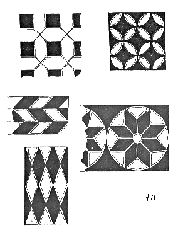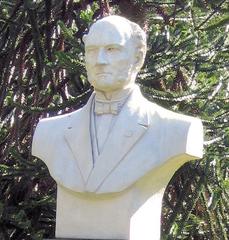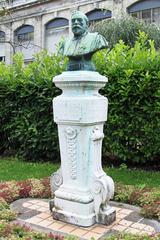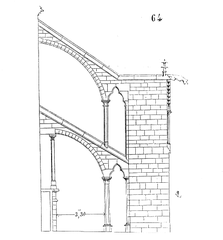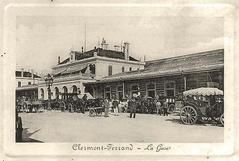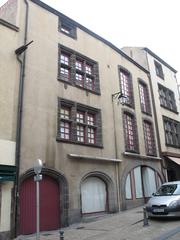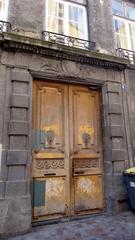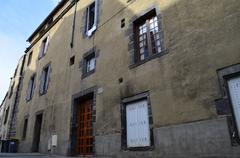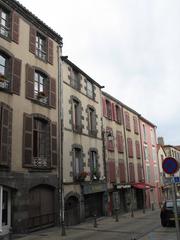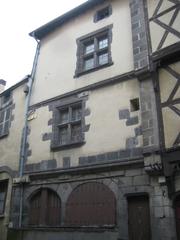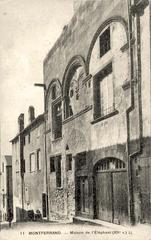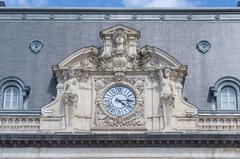Immeuble Bargoin: Visiting Hours, Tickets, and Historical Sites in Clermont-Ferrand
Date: 14/06/2025
Introduction
The Immeuble Bargoin, home to the renowned Musée Bargoin, stands at the heart of Clermont-Ferrand, France, as a monument to both regional history and early 20th-century neoclassical architecture. Founded in 1903 through the philanthropy of Jean-Baptiste Bargoin, the museum exemplifies the city’s cultural ambitions, offering visitors a journey through time via its archaeology and textile collections. Its impressive volcanic stone facade and Corinthian columns reflect local architectural traditions, while its central location near landmarks such as Cathédrale Notre-Dame-de-l’Assomption and Place de Jaude makes it a key destination for heritage and culture seekers (7joursaclermont.fr; Auvergne Destination; Clermont Auvergne Tourisme).
This guide provides comprehensive details on Musée Bargoin’s history, architecture, collections, visitor services, and practical tips, ensuring you are well-prepared for an enriching visit to one of Clermont-Ferrand’s most significant cultural landmarks.
Table of Contents
- Discover the Immeuble Bargoin: A Must-Visit Historical Site
- Architectural Context and Urban Setting
- Architectural Style and Features
- Interior Layout and Accessibility
- Renovation and Heritage Conservation
- Significance in Clermont-Ferrand
- Visitor Information
- Plan Your Visit and Stay Connected
- References
Discover the Immeuble Bargoin: A Must-Visit Historical Site
Historical Background and Architectural Highlights
Immeuble Bargoin was commissioned by Jean-Baptiste Bargoin, whose legacy enabled the city to establish a museum promoting access to arts and heritage (7joursaclermont.fr). Architect Tachet’s design, completed in 1903, features a neoclassical style with Corinthian columns, a central courtyard, and a distinctive spiral staircase (Monumentum). The building’s volcanic stone construction ties it to the local landscape and broader architectural identity of Clermont-Ferrand (The Good Life France).
Visiting Hours, Tickets, and Accessibility
- Opening Hours: Tuesday–Sunday, 10:00 AM–6:00 PM; closed Mondays and public holidays.
- Tickets: General admission €5; reduced €3 (students, seniors); free for children under 18 and residents during special events.
- Accessibility: Fully equipped with ramps and elevators; assistance available upon request.
Getting There and Travel Tips
- Address: 45 rue Ballainvilliers, Clermont-Ferrand.
- Transport: Accessible via several bus lines (including lines 1 and 6); parking at Place de Jaude.
- Best Times: Weekday mornings or late afternoons are quieter; special events offer unique experiences.
Collections and Special Exhibits
Musée Bargoin’s focus is on regional archaeology and world textiles:
- Archaeology: Home to the largest collection of Gallo-Roman wooden ex-votos in Europe, gold coins from the Vercingétorix era, and artifacts from the Arverni tribe’s territory.
- Textiles: Renowned for rare carpets, traditional costumes, and contemporary textile art from five continents (Musée Bargoin Textile Collection).
- Special Exhibits: The “Source des Roches” sanctuary and immersive mixed reality experiences (Clermont Auvergne Volcans).
Nearby Attractions
- Hôtel Regin
- Fontaine d’Amboise
- Musée d’Art Roger-Quilliot
Guided Tours, Events, and Photography
- Guided Tours: Available weekends and by appointment in French and English.
- Events: Nuit des Musées, European Heritage Days, and special workshops.
- Photography: Permitted in designated areas (no flash); the spiral staircase and courtyard are highlights.
Visuals and Virtual Resources
Virtual tours and high-quality images are available on the official website.
Frequently Asked Questions (FAQ)
- Hours: Tuesday–Sunday, 10:00–18:00.
- Tickets: General €5, reductions available.
- Accessibility: Fully accessible.
- Guided Tours: Offered regularly; reservation recommended for English.
Architectural Context and Urban Setting
Location and Urban Integration
Immeuble Bargoin is centrally located in Clermont-Ferrand, close to iconic landmarks, contributing to a rich circuit of urban heritage (POP Culture; Lonely Planet).
Historical Evolution
From its origins in the 19th century as a collection in the Hôpital des Charitains, the museum moved to its current purpose-built home in 1903, marking a pivotal era for the city’s cultural development (POP Culture).
Architectural Style and Features
Neoclassical Influence
The building’s symmetry, proportions, and restrained ornamentation exemplify neoclassical ideals, chosen to express permanence and civic pride (Auvergne Destination).
Facade and Materials
Its stately facade employs local volcanic and Volvic stone, creating a visual link with other notable city structures (The Good Life France).
Entrance and Public Spaces
A classical portico with columns and a forecourt introduces visitors to the museum, emphasizing ceremonial arrival.
Interior Layout and Accessibility
Archaeological Displays
The ground floor hosts archaeological collections in chronological and thematic galleries, making use of abundant natural light (Lonely Planet).
Temporary Exhibitions and Education
Upper floors feature temporary exhibitions, workshops, and interactive spaces, designed for flexibility and family engagement.
Circulation
A grand central staircase provides both functional movement and an architectural focal point. Recent upgrades ensure universal accessibility (Auvergne Destination).
Renovation and Heritage Conservation
Ongoing Projects
As of 2025, major renovations focus on modernizing the infrastructure and collections management, while preserving historical features (Auvergne Destination).
Urban Integration
The museum’s renewal strengthens its role as a cultural anchor and architectural landmark, contributing to the neighborhood’s vibrancy.
Significance in Clermont-Ferrand
Volcanic Stone Architecture
Immeuble Bargoin’s use of volcanic stone mirrors the city’s medieval and modern traditions, visually connecting it to Clermont-Ferrand’s best-known monuments (The Good Life France).
Civic and Cultural Symbolism
Its design and function embody the city’s commitment to education, culture, and public service (POP Culture).
Visitor Information
Hours and Tickets
- Tuesday–Sunday: 10:00–18:00
- Closed: Mondays and public holidays
- Tickets: General €5; reduced €3; under 18 free
Accessibility
- Wheelchair accessible; elevators and ramps on all floors
Getting There
- Address: 45 rue Ballainvilliers
- Transport: Bus, car, and walking options
- Parking: Nearby garages and street parking
Guided Tours and Events
- Regular tours and educational workshops; special events throughout the year
FAQ
- See above for hours, tickets, accessibility, and guided tour details
Plan Your Visit and Stay Connected
- Check the official website for current exhibitions and ticketing
- Download the Audiala app for enhanced experiences
- Follow on social media for updates
- Combine your visit with nearby historical sites
References
- 7joursaclermont.fr
- Auvergne Destination
- Clermont Auvergne Tourisme
- Agenda Culturel
- POP Culture
- Musée Bargoin Official
- Clermont Auvergne Volcans
- Lonely Planet
